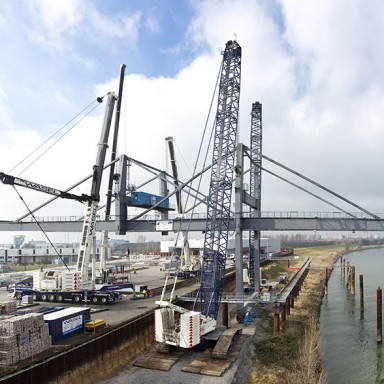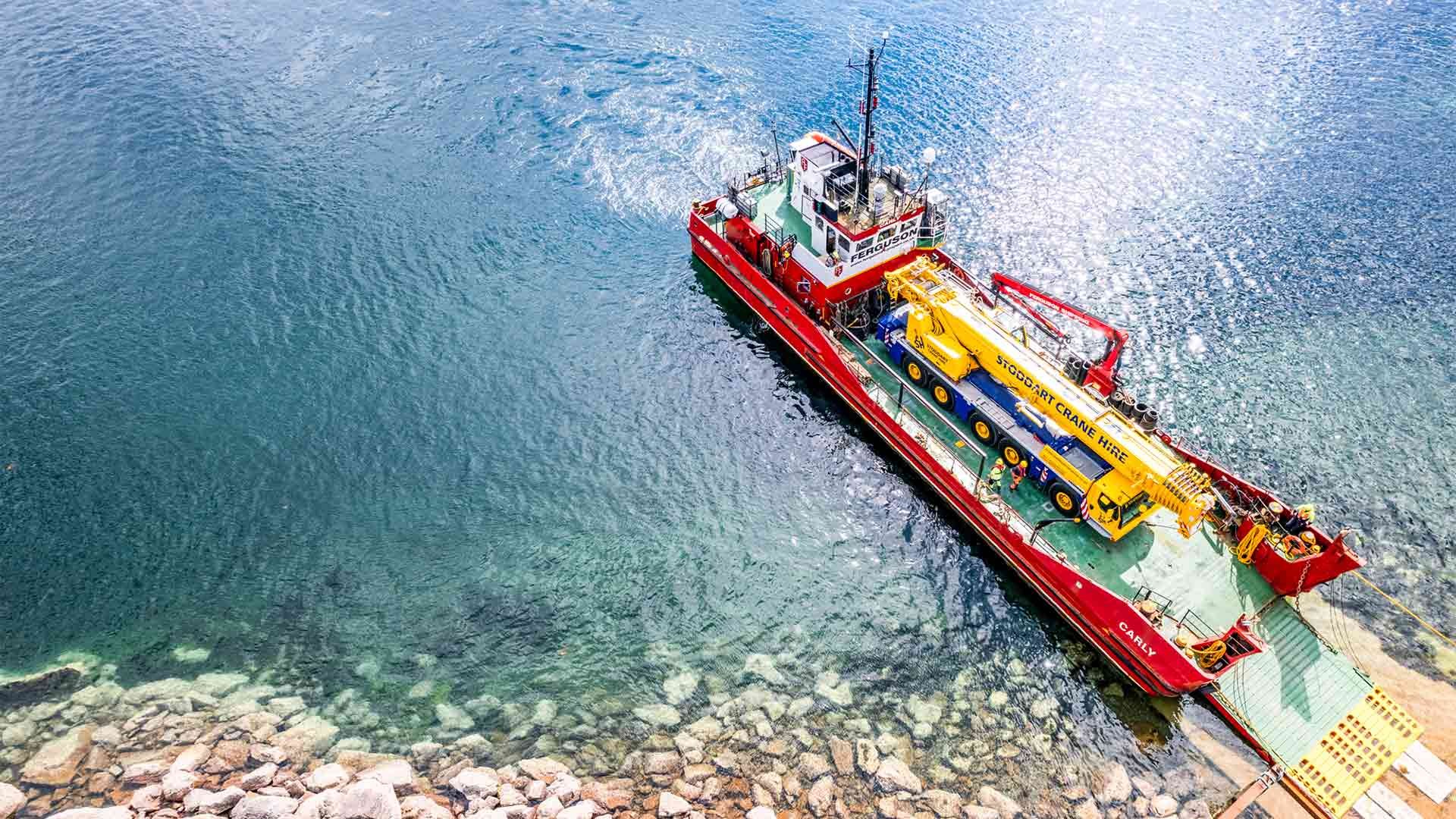
10 minutes - magazine 01 | 2025
Whisky Waves
Do you fancy some sea air, stunningly beautiful nature and a bit of holiday feeling, dear readers? Plus a scent of and even a trace to George Orwell and perhaps a sip of a strong alcoholic beverage? Then join us on a picturesque journey to the north of Great Britain. Let’s go to Scotland! Or to be more precise: on a crane trip through the native country of single malt.
A crane trip to the epicentre of Scotch whisky
We start our small trip not far from the legendary Loch Ness and its monster. Our business partner and customer, Stoddart Crane Hire, have their base slightly to the north, in Muir of Ord, a village in the Highlands. From here, the busy family owned company operates its mobile cranes throughout Scotland and – quite literally – far beyond, as one of their specialties is crane work on the numerous islands off the Scottish coast. Accompany the Stoddart crew on their expedition to the island of Jura off the west coast.
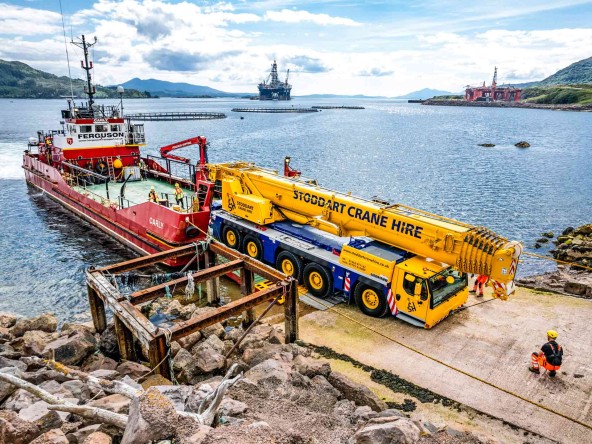
In Scotland, with roughly 150 whisky distilleries, there are naturally several hotspots for the coveted national alcoholic beverage. However, the island of Islay (pronounced ‘Eye-la’) is the heartland with 13 Scotch producers, some of them very well-known. For whisky fans, mentioning Islay and the neighbouring island of Jura with its distillery of the same name in the same breath is almost a sacrilege due to the different characteristics of the alcoholic beverages. Why? Because in the only distillery on Jura, in a small place called Craighouse, single malt is bottled with significantly less smoke and peat aromas and is therefore somewhat milder. Instead, connoisseurs will discover a slight flavour of fruit and dark chocolate in addition to malt and sea.
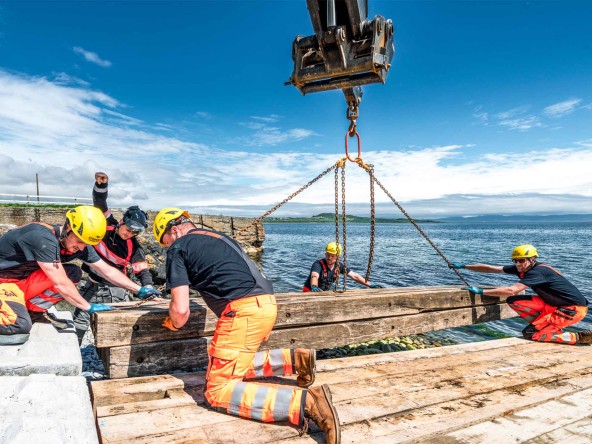
Fully committed: The men from Stoddart are building the provisional ramp on Jura in order that their Liebherr crane can roll ashore from the deck of the landing craft. “Our cranes are constantly in use on the Scottish islands,” says Ewan Stoddart (second from right). A launch pad for space rockets is currently being built on the Shetlands. The blue and yellow cranes from Stoddart are also involved.
Like on Islay, where capacities have been expanded for several years, disused distilleries have been reactivated and even new ones have been founded, Jura is also trying to benefit from the global whisky boom and is expanding. In any case, Stoddart Crane Hire received a request from there to install a new boiler to modernise the distillery. It soon became clear: The largest mobile crane in Stoddart’s fleet was needed to place the 40-tonne component on its base: the LTM 1230-5.1. The question remained how to get the crane to the small island and the construction site.
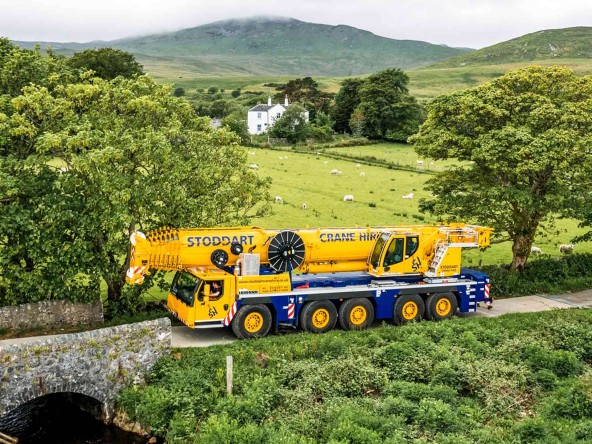
Without ballast or hookblock: The island looks somewhat enchanted in low clouds as the LTM 1230-5.1 drives from the landing place on the island’s only road to its destination. If you follow the path in the opposite direction, you will reach a small house almost at the northern end of Jura, where George Orwell wrote his novel ‘1984’.
A case for junior manager Ewan Stoddart: “On Islay, we have worked for all producers of these whiskies, some of which are world-famous. Thanks to the large ferries, our cranes can easily get there from the mainland. On Jura, by contrast, there is only a landing place for a small car ferry. From there, the only narrow road, some of it built on peat, leads to the distillery. We cannot drive on this road with the mobile crane. So we had to find another solution to get to the construction site with our large 230-tonne vehicle,” Ewan tells us.
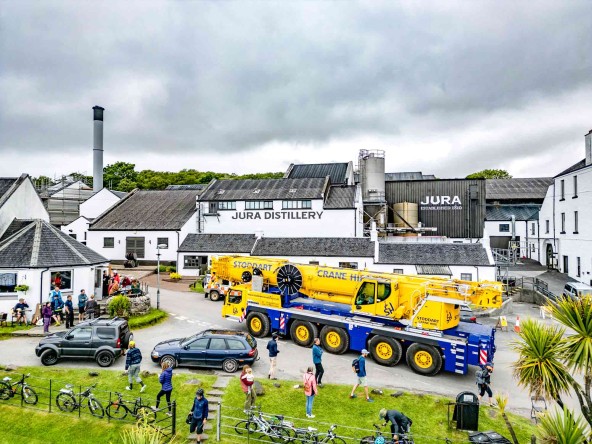
At the destination: The end of a long journey: the LTM 1230-5.1 arrives at the distillery in Craighouse.
Divers in action
This is where the expertise that makes Stoddart Crane Hire so special is involved. The family business, which Ewan runs together with sister Kerri and father David, also specialises in crane operations on the Scottish islands. For this purpose, Stoddart have established an astonishing logistics system to bring cranes and transport operations to the site. Together with long-standing business partner, Ferguson Transport & Shipping, the job on Jura has been planned, inspected and tested for almost two years. Even divers are in action to find a spot on the coast that allows the construction of a provisional pier and the landing of a transport ship and is at the same time not too far away from the distillery location.
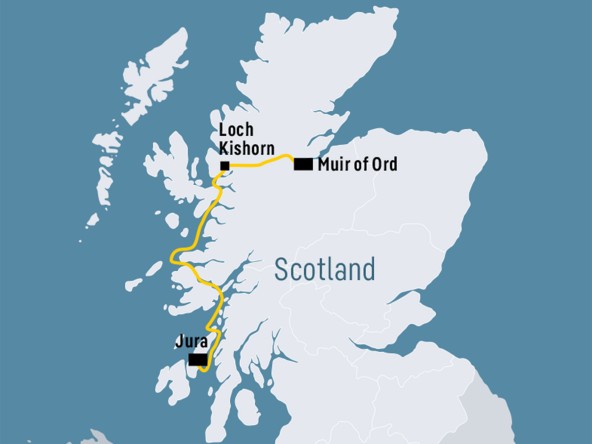
Across the Highlands to the west coast and south by ship – Stoddart Crane Hire specialises in island operations.
Last spring, the time finally came for Ewan and his men to get started. And of course also for our Liebherr crane. From the company headquarters, the mighty five-axle vehicle winds its way for two hours over the rolling hills of the Highlands to the west coast of Scotland – past endless yellow fields of blooming gorse bushes. It passes eight lakes – lochs of different sizes and names. Its destination – Loch Kishorn with access to the open sea. There, ‘Carly’, the landing craft painted bright red, is already waiting to take the LTM 1230-5.1 to the Isle of Jura. Together with the ship’s crew, Ewan and his men have to wait on the shore for a few hours. The tide is still too high. Then, when the water level is ideal within the tides, the men carefully guide the crane over the concrete ramp leading into the water onto the transport ship. To minimise the weight of the load for the sea voyage, the ballast blocks and the hookblock are brought to the construction site separately. On board, the mobile crane is secured with heavy chains, then the ‘Carly’ casts off and heads for its destination: the Isle of Jura.
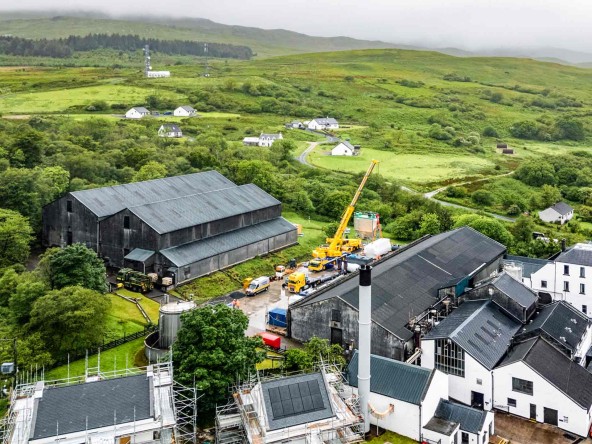
On the island
Two days later, the landing craft has completed the 130 nautical miles or 250 kilometres to the south. In the meantime, on Jura, work is being carried out at full speed on the provisional landing place and parts of the route are already covered with metal plates. The significant effort involved is worth it: The ship and its heavy cargo can land without any problems and crane operator Nikki easily steers his vehicle off the ship over the ramp made of concrete blocks, gravel and heavy Bongossi timbers. After a brief check, the two-mile journey to the whisky distillery begins. We make our way quickly to Craighouse past a small group of grey seals dozing unimpressed on large rocks near the shore. In the only larger village on the island with a hotel, camping site and small shops, the mobile crane pushes its way up to the dominant white brick buildings of the distillery, past the curious tourists who are already on the island in large numbers in May.
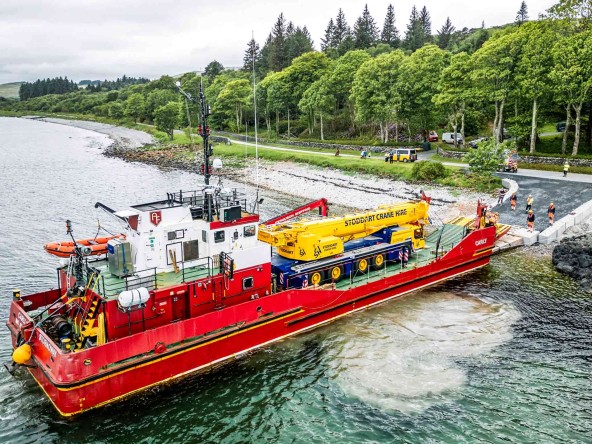
Mission accomplished: The LTM 1230-5.1 starts its return trip to the Scottish mainland. The makeshift landing place was built especially for the transport ship.
By the way, if you take the narrow road in the opposite direction until it ends at a barrier, you will come very close to the birthplace of a masterpiece of world literature. Those who don’t mind the subsequent hike will eventually reach Barnhill, a compact, whitewashed cottage. After the Second World War, the writer George Orwell found his home here in the final years of his life and – as he wrote – he also found refuge and peace in the harsh beauty of the island. It was in this isolation that he wrote his novel ‘1984’, his last and, alongside ‘Animal Farm’, best-known work.
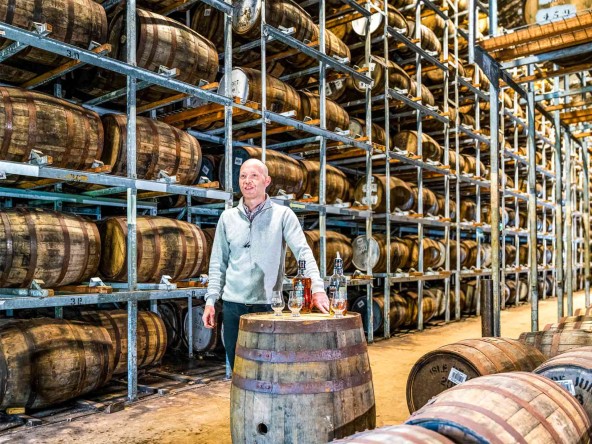
24,482 casks of whisky
Whether the passionate smoker Orwell bought himself single malt on the island is not known. Graham Geddes cannot confirm this either. Graham comes from a small family dynasty of Scottish whisky distillers and started in the industry as a masher more than 20 years ago. He finally became a distiller, he explains. He is now standing in front of us as Managing Director of the Isle of Jura distillery. And in front of thousands of whisky casks. “There are exactly 24,482 casks here in our three warehouses,” says the new distillery manager. He naturally knows much, much more and is happy to tell us. About the distillery’s 200-year history with its many changes of owner and its closure around 1900, which lasted six decades. About the demolition of the old buildings and the reconstruction in the 1960s. Or about the fact that each of his distilled products is first stored for a few years in former Bourbon casks before being transferred to casks for refinement that were previously used for storing rye mash, wine or rum. Depending on the desired finish.
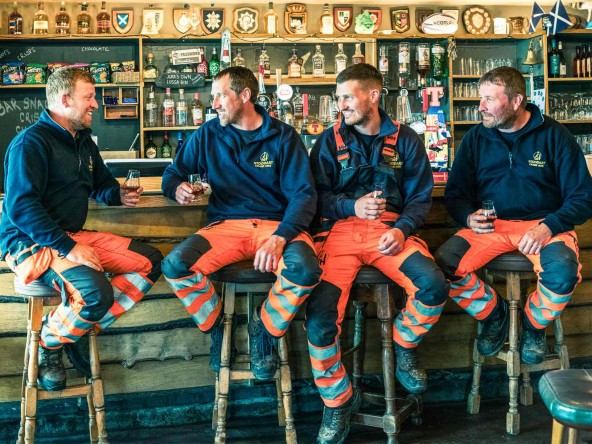
Fake whisky in the glass: When work was almost done, we nudged the men from Stoddart into the well equipped bar of the ‘Jura Hotel’. Simply too tempting was the final image of this charming trip into the world of our mobile cranes. (Incidentally, for the photo of this likeable squad, coke had to be diluted with tap water until the colour in the glass resembled that of Jura whisky). On the left-hand bar stool: Ewan Stoddart, one of the Managing Directors of the family business. Nikki Webster, Steven Sharpe and Steven Stoddart are simulating the drink next to him. Thanks guys & cheers. Or rather in Scottish: Slàinte.
And he describes the logistical challenges posed by the remote location on the island – including for the planned extension of the distillery. “Here at the production site, we are reaching the limits of our capacity with warehouses that are full to the brim,” continues Graham. “We currently have to transport all new distilled products to the Scottish mainland for maturing. That is also because one of the four huge warehouses had to be demolished to make room for a new, modern plant. This forward-looking project is aiming at further reducing the CO₂ footprint of our distillery. This is why we are installing a large biomass boiler for the first time.”
Compared to the preparations and hardships of the adventurous trip, the boiler is installed on site the next day by Ewan Stoddart and his men using the large mobile crane in a completely unspectacular manner within only a few hours. A small Liebherr compact crane is also involved. This LTC 1045-3.1 has been in use for all sorts of work on the construction site for many weeks now. It will remain on the island for quite some time to position smaller plant components, then provide assembly support in the steel construction and be used for the construction of a silo. However, after its use, the large crane will go straight back to the landing place of the landing craft, which will take it back to the mainland. There, new tasks are waiting for it and the men from Stoddart Crane Hire. Including on the many islands in the Scottish Sea.
This article was published in the UpLoad magazine 01 | 2025.


